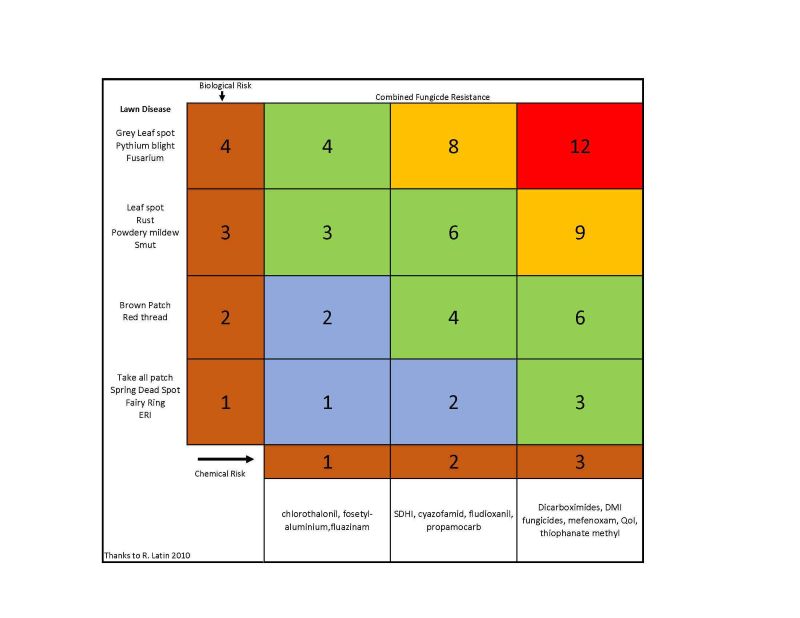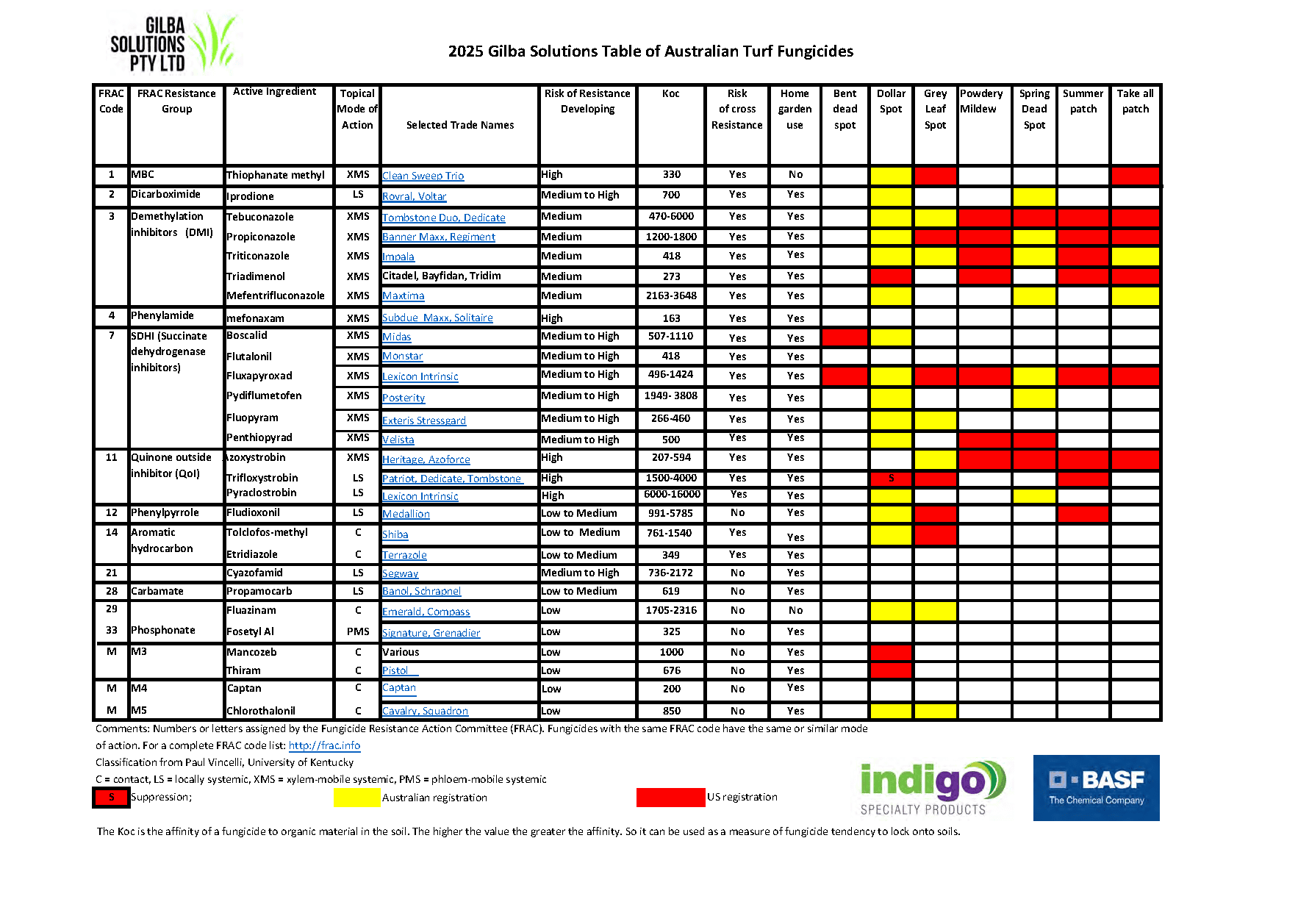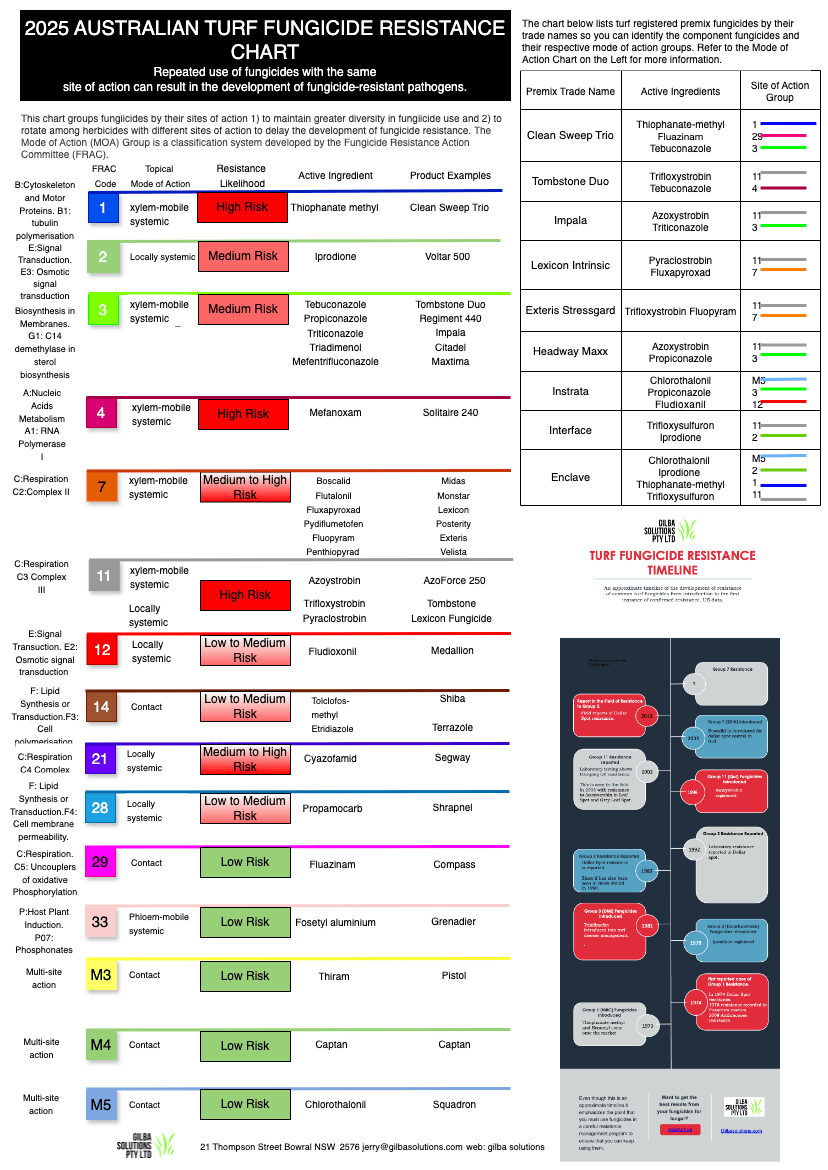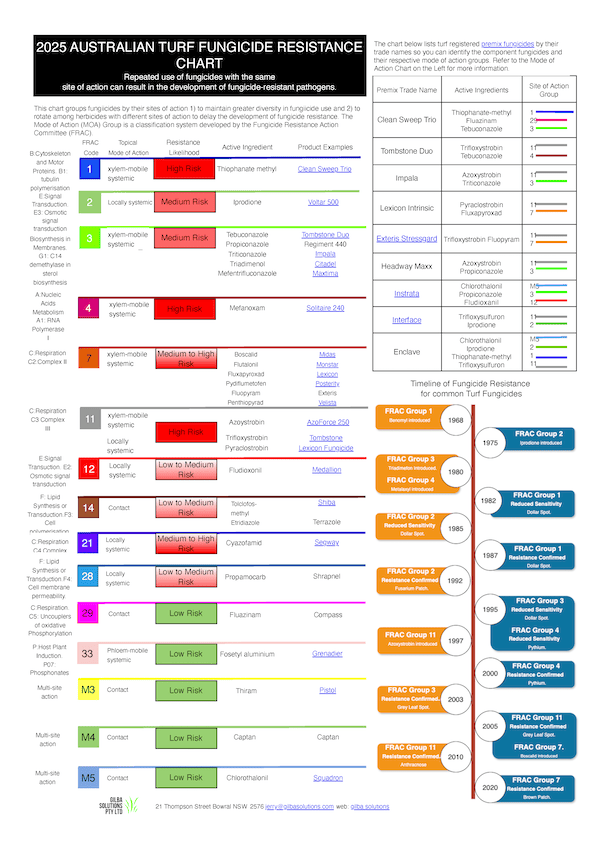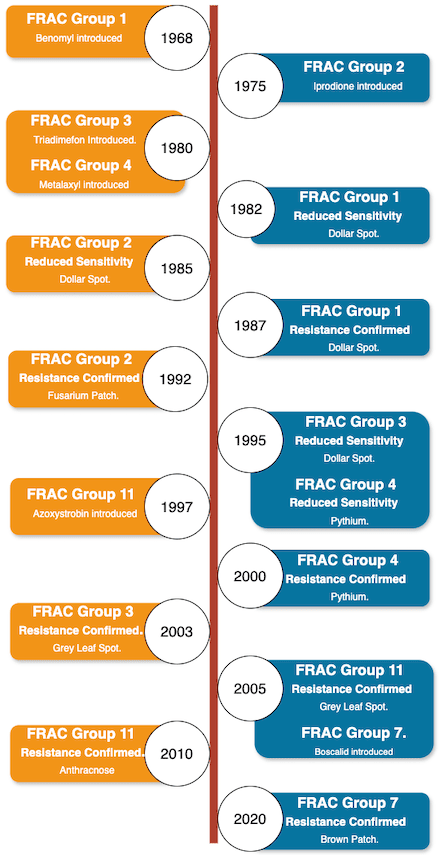Turf Fungicide Mode of Action Table
This discusses Turf fungicide resistance and in fungicide mode of action groups. Fungicide resistance is the ability of fungae to survive exposure to fungicides that would normally kill or inhibit their growth. This fungicide mode of action table is to help manage the onset of fungicide resistance.
Fungal cells are able to develop genetic mutations that allow them to tolerate fungicides. These resistant cells are able to survive and reproduce and over time, the proportion of resistant cells in a population can increase. This then makes it more difficult to control the fungus with the fungicide.
Turf fungicides are used to control diseases such as dollar spot, brown patch, and fairy ring. The same principles of disease control apply to both professional turf managers and home lawn owners. However, the overuse or improper use of fungicides can lead to fungicide resistance in fungal populations.
If you rotate fungicides with different fungicide mode of action groups, use fungicides in combination, and use cultural practices to reduce fungal populations you can manage resistance. Cultural practices include irrigation management, fertilization, mowing, and aeration.
Fungicide Rotation.
A strategy of fungicide rotation helps manage fungicide resistance. This is when you use different fungicide mode of action groups to prevent the build-up of resistance in fungal populations. The IGFH Guide to Australian Turf pesticides goes into more detail on this topic but the following is a summary.
Fungicides have different modes of action. A mode of action refers to the way in which fungicides kill or inhibit the growth of fungal pathogens. So for example the mode of action of the fungicide azoxystrobin, differs from that of chlorothalonil.
If you rotate fungicides with different modes of action, the chances of a fungal population developing resistance to a single fungicide reduces. To achieve this alternate between fungicides with different modes of action during a single season, or use fungicides with different modes of action in successive seasons.
Fungicide rotation is used in combination with other resistance management strategies. These include the use of combination fungicides like Lexicon Intrinsic, and cultural practices to reduce fungal populations.
It’s important to keep track of the fungicides that you use and when you apply them to ensure that any rotation is effective.
Fungicide resistance can develop quickly, so use fungicides responsibly, and in rotation with other products and management practices. It’s also important to monitor for resistance and to adjust management strategies accordingly.
Australian Turf Fungicide Mode of Action Table.
1. Understand what this table is for.
2. Identify the columns.
Familiarize yourself with the table’s column headings. Each column provides information about these turf fungicides and their properties.
3. What does each column mean?
Here’s what each column represents:
-
- FRAC Resistance Group: Fungicides are put into Groups or classes based on their modes of action.
- Fungicide active ingredient: What it contains.
- Product name: Lists some examples of common turf fungicides.
- Mode of Action: Describes the specific process that affects in the target organism.
- Diseases controlled: Specifies the turf diseases that you can use the turf fungicides for in Australia.
4. Determine Target Disease.
Identify the fungal disease. This useful turf disease guide helps with this.
5. Choose the appropriate Group or Class.
Look for the group or class of fungicides that are effective against your target disease. Cross-reference the fungicide group or class with the target disease column to find your options.
6. Rotate Fungicides.
It is crucial to rotate fungicides with different modes of action to prevent fungal resistance. Refer to the mode of action column to select a fungicide from a different group or class for future use.
7. Follow the Label:
Once you identify a suitable fungicide, read the product label and follow the use rates, timing, and safety precautions. This advice also relates to whether it is legal to use a specific fungicide in a home lawn situation.
8. Monitor and Assess Efficacy:
After you apply the fungicide, monitor the turf for disease, and evaluate how well it works. If necessary, consult with a local turf agronomists or sports turf consultants for further guidance.
Fungicide Resistance Management for Turf.
- Anthracnose (azoxystrobin and thiophanate methyl).
- Gray leaf spot (azoxystrobin and theoretical cross resistance to all QoI/strobilurin’s), and possibly thiophanate-methyl) and
- Pythium blight to metalaxyl and mefenoxam.
- Preventive applications of fungicides are effective when you use different FRAC groups (i.e., modes of action) to deal with high risk diseases such as dollar spot, gray leaf spot and anthracnose.
- Curative sprays should include two different modes of action (see FRAC Codes).
Single Site or Multi-site?
Single site turf fungicides are at a medium to high risk of resistance. Being single-site means they act at a specific point in the pathogen.
Multi-site fungicides are mostly contacts such as Squadron Weatherace, and have many different target sites. This means there is less of a risk as it requires more changes in the pathogen for resistance to occur.
Rotate.
Do not use site specific fungicides from the same group more than twice in a row. This also applies if you use premix combination fungicides such as Quali-Pro Enclave.
In an ideal situation aim to use multi-site fungicides as often as you can, as they have low to no risk for resistance.
Interestingly, CropLife has publishes these resistance guidelines for turf grass.
- Groups with a medium to a high risk for fungicide resistance development; Groups 1, 2, 4, 7 (N3), 11 and 21. Rotate these to reduce the development of resistance.
- Do not apply consecutive sprays from the same activity group, unless they are mixed with a fungicide from a different mode of action group with no known resistance.
- Group N3 nematicides are also classed as Group 7 fungicides, so avoid repeat use even if you target different pests or pathogens.
- If you apply consecutive sprays from a high-risk fungicide group (i.e. Group 1, 2, 4, 7, 11 or 21) you must follow the use of these with at least the same number of applications of fungicide(s) from a different group(s) before you use the same high-risk fungicide again.
Apply the correct rates.
On so many occasions we have seen turf managers change the use rates as it “didn’t work last time”. This is a big no no. Stick to the label rates.
Practice integrated disease management (IPM).
Don’t just say you do it. Actually do do it! IPM practices will break any disease cycle. Increase the air flow, reduce turf stress and use resistant cultivars of bent grass or ryegrass saves you a lot of money in the long term.
Consider the use of products such as salicylic acid in any IPM plan as these help counter any resistance issues. The turf pigment and grass colorant Vertmax Duo contains this.

Jerry Spencer
Jerry has an Hons Degree in Soil Science (1988) from Newcastle Upon Tyne University. He then worked as a turf agronomist for the Sports Turf Research Institute (STRI) until 1993.
He gained a Grad Dip in Business Management from UTS in 1999. He has held a number of technical roles for companies such as Arthur Yates (Commercial Technical Manager) and Paton Fertilizers (Organic, turf specialty and controlled release fertiliser) portfolios.
In 2013 he established Gilba Solutions as independent sports turf consultants and turf agronomists. Jerry has written over 100 articles and two books on a wide range of topics such as Turf Pesticides and turfgrass Nutrition which have been published in Australia and overseas.

